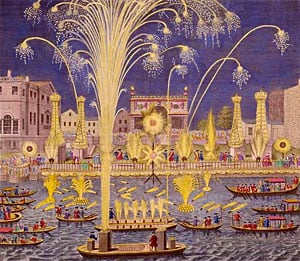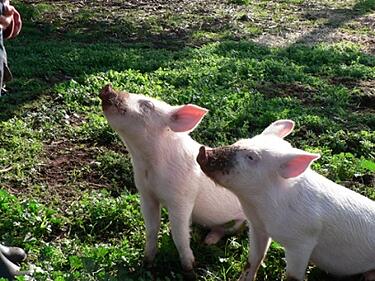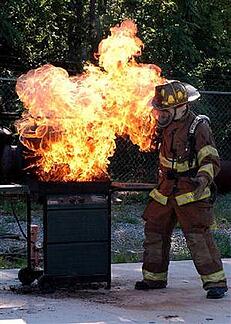Independence Day (AKA ‘Fourth of July’) has been celebrated with fireworks since 1776, when the United States declared its independence from Great Britain (now known as the United Kingdom).
 Fireworks themselves are dated back to 7th century China, where they were invented and used in many festivities. Fast forward to mid-17th century; Europe was blown away by Chinese fireworks and the popularity would rise and they were used for celebration of many important events. Finally in the late 18th century, the early European settlers brought this love of fireworks to this country and used them as rally devices, political attractions, and of course to celebrate important events.
Fireworks themselves are dated back to 7th century China, where they were invented and used in many festivities. Fast forward to mid-17th century; Europe was blown away by Chinese fireworks and the popularity would rise and they were used for celebration of many important events. Finally in the late 18th century, the early European settlers brought this love of fireworks to this country and used them as rally devices, political attractions, and of course to celebrate important events.
In times past, pyrotechnicians were highly respected individuals and the art of making fireworks was a complex science with its own knowledge and techniques. Today, we have fireworks displays for festivals and celebrations, and even competitions, around the world. Did you know that the largest consumer of fireworks in the United States is the Walt Disney Corporation?
Unfortunately somewhere down the line fireworks got arguably too popular and now we have many individual consumers purchasing and igniting their own. This isn’t in itself bad, but two things are happening: people are not taking proper safety precautions and the injuries are piling up yearly, and other people are making their own. Remember when I said pyrotechnics were an art and a science? Making your own fireworks is a recipe for disaster unless you are a professional, and the numbers below will show it. Despite the dangers of fireworks, few people seem to truly understand the associated risks including devastating burns, other injuries, fires, and even death.
Failure to follow these fireworks safety tips can lead to serious burns, injuries, or even worse! In 2012, an estimated 9,200 people were treated in emergency rooms for fireworks-related injuries. 36% of this number was under the age of 15. In fact, children between the ages of 10 and 14 are at three times the risk of fireworks-related injuries than the general population.
Quick Facts/Statistics about Fireworks
- In 2011, fireworks caused about $32 million in direct property damage.

- In 2012, more than 36% of fireworks-related injuries in Indiana were to children under 18 years old.
- Also in 2012, U.S. hospital emergency rooms treated an estimated 8,700 people for fireworks-related injuries.
- 55% were to the arms/legs combined and 31% were to the head.
- On Independence Day in a typical year, far more U.S. fires are reported than on any other day, and fireworks account for 2 out of 5 of those fires, more than any other cause of fires.
- 65% of the fireworks injuries in 2013 occurred during the month surrounding July 4th.
- Illegal and homemade fireworks were involved in all 8 fireworks-related deaths reported in 2013.
- Top 2 fireworks types from injuries were Sparklers (31%) and Firecrackers (11%).
- Sparklers burn at extremely hot temperatures, from 1200 to 1800 degrees Fahrenheit.
- Sparklers burn at extremely hot temperatures, from 1200 to 1800 degrees Fahrenheit.
And finally, I leave you with the 10 tips to keep you safe this Independence Day.
- Make sure fireworks are legal in your area before buying or using them.
- Avoid buying fireworks that are packaged in brown paper, which is often a sign that the fireworks were made for professional displays and could pose a danger to consumers. And remember, homemade fireworks are also dangerous and illegal!
- Never ignite fireworks indoors. Fireworks should only be lit on a smooth, flat surface; and should always be away from buildings, dry vegetation, and flammable materials.
- Never ignite fireworks in a metal or glass container.
 Keep any type of ladder or pole (used to set up or light fireworks) at least 10 feet from any power lines.
Keep any type of ladder or pole (used to set up or light fireworks) at least 10 feet from any power lines.- Never point or throw fireworks at a person, animal, or building.
- Fireworks should not be used by persons under the influence of drugs or alcohol.
- Light fireworks one at a time, then back away quickly. Never place any part of your body directly over the fireworks themselves when lighting the fuse and never attempt to relight a “dud.”
- Have a fire extinguisher, water hose, or water-filled bucket nearby. Fireworks stay hot for a bit after they’ve burned out. Douse and dispose!
- Never allow young children to use fireworks. This includes sparklers, as they burn at temperatures hot enough to melt some metals. For older children, always have adult supervision when they are using or around fireworks. (Glowsticks make a great alternative to fireworks for young children).
Remember to stay safe this holiday and practice situational awareness. Accidents are preventable, if we practice good safety culture.
And remember, July is also National UV Safety Month! Head over to our previous July blog article covering safety tips to beat the heat. Click here to read 5+ Tips to Survive UV Safety Month this July.
Safety Training Services is here for ALL your safety needs! Whether its OSHA compliant safety training, first aid kits & fire extinguisher, equipment & supplied air rentals, field (rescue) work, or consulting, STS can help you and your company! Click here for 'Real Experience. Real Training. Real Results.'


 rays. The color and how expense they were mean nothing compared to the REAL reason we wear sunglasses.
rays. The color and how expense they were mean nothing compared to the REAL reason we wear sunglasses. UV radiation is not limited to just us humans either. Both plants and other animals are affected by it. For example, a plant's overexposure to the sun could mean affecting its photosynthesis. This can affect the growth of the plant, and therefore can potentially impact the structure of an ecosystem in a negative way. Animals, especially those with little to no hair, can get sunburn just like any of us. This is why pigs (and other similar animals) roll around in the mud, they use it like sunscreen!
UV radiation is not limited to just us humans either. Both plants and other animals are affected by it. For example, a plant's overexposure to the sun could mean affecting its photosynthesis. This can affect the growth of the plant, and therefore can potentially impact the structure of an ecosystem in a negative way. Animals, especially those with little to no hair, can get sunburn just like any of us. This is why pigs (and other similar animals) roll around in the mud, they use it like sunscreen!



